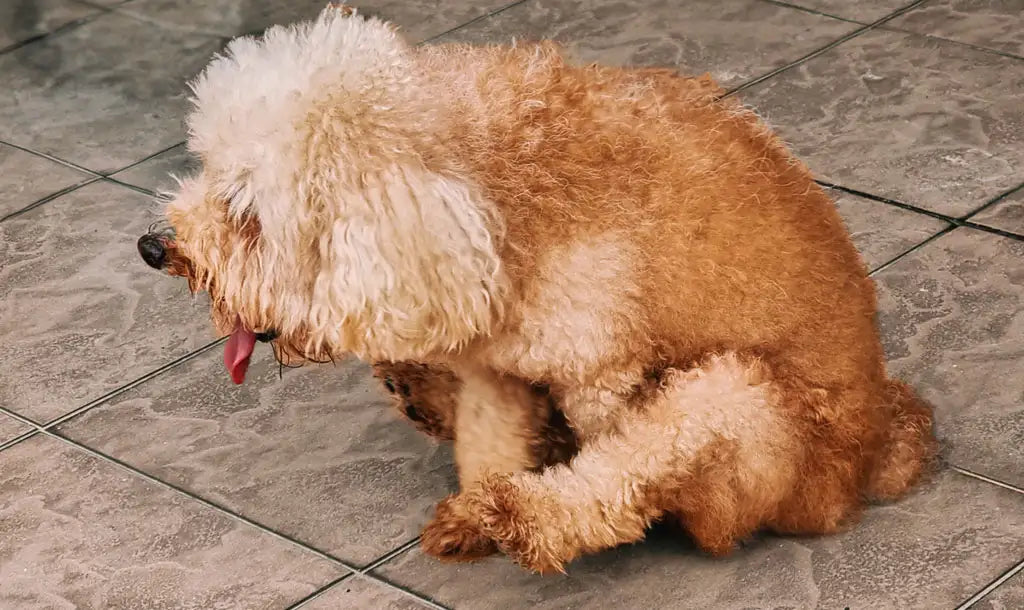Anal gland issues in dogs (and sometimes cats) are a common modern problem, often stemming from dietary, lifestyle, and environmental factors. In a healthy pet, these scent glands help with communication and should express naturally during defecation. However, many dogs (and some cats) today suffer from chronic gland issues due to recurrent inflammation, poor diet, allergies, and microbiome imbalances.
These tiny glands are located just inside your pet’s rectum at around the 4 o’clock and 8 o’clock positions. These sacs are lined with oil and sweat glands and produce a thick, yellowish-brown liquid with a distinctly fishy odor—once you smell this odor you’ll never forget it.
Normally, when your dog (or cat) has a bowel movement, the pressure of the stool naturally squeezes these glands, releasing a small amount of fluid. This scent-marking behavior is actually an important form of communication among dogs—which is why sniffing each other’s behinds is like reading a name tag at a party. But when things aren’t functioning properly—the ducts that drain the anal glands can become inflamed, blocked and then infected.
Why Pets Develop Anal Gland Problems
- Loose stools from poor diet and gut health: Ultra-processed pet food and low-fiber homemade diets can contribute to soft stools and inflammation, preventing natural gland emptying.
- Allergies and food sensitivities: Common triggers like chicken, beef, dairy, and grains often cause gland irritation and scooting.
- Microbiome imbalance: Disrupted gut flora reduces stool quality and can increase perianal inflammation.
- Chronic, recurring gland inflammation: Often tied to unnecessary expression of glands by groomers or vets
- Structural or muscular issues: Small or overweight dogs and cats may struggle with natural expression due to poor muscle tone or conformation (the glands are positioned abnormally in some breeds)
Getting to the Root of the Scoot
- Address allergies: Eliminate common food allergens and consider food sensitivity testing (such as Nutriscan® testing) or food trials with ingredients your pet has never consumed before.
- Investigate the microbiome: find out if flora imbalances are contributing to recurring gut issues by testing your pet’s microbiome (VDI labs, AnimalBiome, MiDOG, and Embark have test kits for dogs and cats)
- Consider functional GI testing to determine why stools are irregular, including TLI (Trypsin-Like Immunoreactivity) and PLI (Pancreatic Lipase Immunoreactivity) to assess pancreatic function, cobalamin (vitamin B12) and folate to evaluate small intestinal absorption and bacterial overgrowth
- Rule out common root causes of chronic soft stools, including giardia (and other parasites) and GI lymphoma
- Add prebiotic-rich foods and soil-based probiotics if there’s a history of antibiotic use. A 2021 study in the Canadian Journal of Veterinary Research 1 examined the anal gland microbiome and found what type of bacteria naturally occur in the glands of healthy dogs, including five main types: Firmicutes, Bacteroidetes, Proteobacteria, Actinobacteria, and Fusobacteria. The study showed that the diversity and richness of the bacterial microbiota of the anal sacs in dogs is greater than what has been reported. Antibiotics disrupt the GI and anal gland microbiomes, potentially creating chronic issues if healthy bacteria aren’t replaced
- Regular Exercise: Movement helps with natural expression and weight management. Walks in the woods and exposure to healthy, chemical-free soil has been associated with higher levels of fusobacteria 2
- Stop squeezing healthy glands
Why Groomers Should Not Routinely Express Healthy Glands
Routine manual expression of anal glands by groomers (or vets) can do more harm than good. In healthy dogs, glands should naturally empty as feces pass out of the rectum. Regular manual expression as a part of the grooming process causes unnecessary inflammation and can damage the delicate ducts, leading to chronic dependence or repeated infections. Unless a dog has a medical issue requiring expression, it’s best to avoid this practice.
Managing Damaged Glands– To Squeeze or Not to Squeeze
Diagnosing the type of anal gland problem your pet is experiencing requires veterinary palpation of anal glands to determine what’s going on. The most common scenarios are:
Anal gland inflammation (also called anal sacculitis) occurs when the glands and/or ducts become irritated and swollen, often due to underlying allergies, infections, or trauma. Affected pets may scoot, lick excessively, or show signs of discomfort. Oftentimes, squeezing glands makes the inflammation worse. As long as the glands aren’t becoming impacted and the fluid can still exit the gland, it’s best to leave the irritated tissue alone, closely monitor, and implement the inflammation-controlling strategies suggested here.
Calendula 4 and Chamomile 5 Compresses are both anti-inflammatory and antimicrobial, helping to reduce irritation and prevent secondary infection. Calendula tincture can also be used for compresses. Herbal poultices can be a supportive way to soothe inflamed or impacted anal glands in dogs and cats (if they’ll cooperate).
Anal gland impaction happens when the glands fail to empty properly, causing the fluid to thicken and accumulate. This creates pressure, pain, and typically leads to scooting or straining to defecate. Impactions can become infected if not gently and thoroughly expressed. Difficult expression can be facilitated by or followed up with an infusion of lubricating silver sulfadiazine (SSD), diluted with colloid silver enough that a cannula can be inserted into the gland. This approach can often resolve underlying infection without contributing to long-term damage or dysfunction. Repeated infusions several times a week may be needed to resolve chronic impactions and help re-establish healthy gland function by providing ongoing anti-microbial lubrication of the ducts.
If your pet develops an impaction or the gland abscesses and ruptures, veterinarians can treat the problem by gently flushing the gland with dilute betaine or chlorhexidine, then infusing the anal gland with silver sulfadiazine (SSD), diluted with colloid silver enough that a cannula can be inserted into the gland. This approach can resolve inflammation and infection without contributing to long-term damage or dysfunction. Ozonated coconut or olive oil salves can also be very soothing when applied topically to the area.
Castor oil packs are a traditional remedy to help soften tissue, reduce inflammation 3, and promote lymphatic flow for mild impactions. If infection is present, a Plantain Poultice can be very beneficial. Plantain (Plantago major) is astringent, anti-inflammatory, and helps draw out irritation and infection 6. It’s a traditional remedy for abscesses, bites, and minor wounds. Ruptured anal glands ooze; it’s important to keep area disinfected with dilute povidone iodine at least twice a day and prevent licking.
Anal gland fibrosis refers to the hardening and thickening of the glandular tissue from scar tissue, usually due to repeated infections, inflammation, or manual expression. This chronic condition can impair normal gland function and may require surgical intervention if severe. Expressing glands may be necessary because of scarring.
Anal gland tumors are abnormal growths, often malignant (like apocrine gland adenocarcinomas), that can enlarge and invade nearby tissues. They may cause swelling, bleeding, or difficulty defecating, and require prompt diagnosis and often surgical removal with possible follow-up treatment. Elevated blood calcium levels (hypercalcemia) can be a clinical sign of anal gland tumors, particularly apocrine gland adenocarcinomas, due to their ability to produce parathyroid hormone-related protein (PTHrP).
Rebuilding Anal Gland Health With Systemic Support
Reduce whole-body inflammation by transitioning to a fresh, nutritionally complete (raw or gently cooked), human-grade diet. AGEs, or Advanced Glycation End products (detrimental chemical reactions that occur as a result of high-heat processing) in ultra-processed pet food (kibble) contribute to ongoing systemic inflammation.
Add in Bowel Band-Aids, If Needed
While identifying and addressing the underlying root cause(s) of anal gland issues, also work on creating perfect bowel movements by adding stool-corrective supplements for bowel imbalances.
Slippery Elm is great for pets with chronic soft stools. For dogs with IBS (Irritable Bowel Syndrome), where constipation and loose stools are both cyclically present, psyllium husk and/or apple pectin can support bowel balancing and regularity. Constipated dogs can become more regular by adding raw, organic chia or flaxseeds to meals, which provide fiber and alpha-linolenic acid (ALA). Ground leafy greens like spinach or dandelion, cooked okra, or cooked, pureed culinary mushrooms offer natural fiber and detoxifying support for pets. Canned 100% pumpkin also works wonders for many pets.
Reduce systemic inflammation by supplementing with Omega-3s (DHA/EPA), Quercetin, and Curcumin.
Astragalus (Astragalus membranaceus) is a well-known herb traditionally used in Chinese medicine to support immune function. In pets, astragalus may help combat infections by enhancing the activity of white blood cells, increasing antibody production, and supporting the body’s natural antibacterial defenses7. This is a great add-in if infection is present.
In the end, addressing anal gland problems is about more than just symptom management—it’s about restoring your pet’s overall vitality by identifying and resolving the underlying imbalances that contribute to gland dysfunction. With a focus on real food nutrition, microbiome support, and inflammation control, we can create an internal environment where anal glands function as nature intended—quietly and without issue. While it may be tempting to consider surgical removal for recurring problems, this procedure should be reserved only as a last resort. Anal glands play an important role in natural communication and waste elimination, and removing them can lead to serious complications, including nerve damage and fecal incontinence. By working to heal rather than remove, we honor the body’s design and support our pets in achieving long-term, whole-body wellness.





